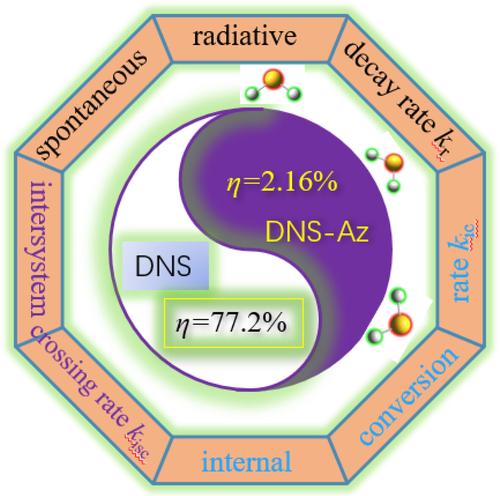当前位置:
X-MOL 学术
›
J. Comput. Chem.
›
论文详情
Our official English website, www.x-mol.net, welcomes your
feedback! (Note: you will need to create a separate account there.)
Theoretical study on the luminescent and reaction mechanism of dansyl-based fluorescence probe for detecting hydrogen sulfide
Journal of Computational Chemistry ( IF 3.4 ) Pub Date : 2024-09-26 , DOI: 10.1002/jcc.27506
Huixue Li 1 , Yvhua Wang 1 , Sujuan Pan 1 , Changqing Wang 1 , Yanzhi Liu 1 , Kun Yuan 1 , Lingling Lv 1 , Zhifeng Li 1
Journal of Computational Chemistry ( IF 3.4 ) Pub Date : 2024-09-26 , DOI: 10.1002/jcc.27506
Huixue Li 1 , Yvhua Wang 1 , Sujuan Pan 1 , Changqing Wang 1 , Yanzhi Liu 1 , Kun Yuan 1 , Lingling Lv 1 , Zhifeng Li 1
Affiliation

|
The photophysical and photochemical properties of the sulfonyl azide-based fluorescent probe DNS–Az and its reduction product DNS by hydrogen sulfide (H2S) have been investigated theoretically. The calculated results indicated the first excited states of DNS–Az was dark state (oscillator strength less than 0.03) and DNS was bright state (oscillator strength more than 0.1), which determined the predicted radiative rate kr of DNS–Az was much smaller than that of DNS, meanwhile, due to more larger reorganization energy of DNS–Az, its predicted internal conversion rate kic was four times larger than that of DNS; moreover, owing to the effect of heavy atom from sulfur atom in DNS–Az, its predicted intersystem crossing rate kisc was seven times larger than that of DNS, thus the calculated fluorescence quantum yield of DNS–Az was only 2.16% and that of DNS was more than 77.2%, the above factors is the basis for DNS–Az molecule to function as a fluorescent probe. Regarding both DNS-Az and DNS molecules, their maximum Huang-Rhys factors, which are less than unity, signify the reliability of 0–0 transitions between their S0 and S1 electronic states. In addition, for DNS, our simulated emission peak of the 0–0 transition is 515 nm, a value that exhibits enhanced accuracy and coherence when compared to the experimental datum of 528 nm. The reaction mechanism of DNS-Az generating DNS by H2S has been investigated too, according to the potential energy profile, we found that the fluorescent probe firstly protonated, then this organic ion broke down into DNS with the aid of a proton.
中文翻译:

丹酰基荧光探针检测硫化氢的发光及反应机理的理论研究
已经从理论上研究了基于磺酰叠氮化物的荧光探针 DNS-Az 及其硫化氢还原产物 DNS (H2S) 的光物理和光化学性质。计算结果表明,DNS-Az 的第一激发态为暗态(振荡器强度小于 0.03),DNS 为亮态(振荡器强度大于 0.1),这决定了 DNS-Az 的预测辐射率 kr 远小于 DNS,同时,由于 DNS-Az 的重组能量更大, 其预测的内部转化率 kic 是 DNS 的 4 倍;此外,由于 DNS-Az 中硫原子的重原子的作用,其预测的系统间穿越速率 kisc 是 DNS 的 7 倍,因此 DNS-Az 的计算荧光量子产率仅为 2.16%,DNS 的荧光量子产率超过 77.2%,以上因素是 DNS-Az 分子作为荧光探针发挥作用的基础。对于 DNS-Az 和 DNS 分子,它们的最大 Huang-Rhys 因子(小于 1 )表示其 S0 和 S1 电子态之间 0-0 跃迁的可靠性。此外,对于 DNS,我们模拟的 0-0 跃迁发射峰为 515 nm,与 528 nm 的实验基准面相比,该值表现出更高的准确性和连贯性。也研究了 H2S 生成 DNS-Az 的反应机制,根据势能分布,我们发现荧光探针首先质子化,然后这个有机离子在质子的帮助下分解成 DNS。
更新日期:2024-09-26
中文翻译:

丹酰基荧光探针检测硫化氢的发光及反应机理的理论研究
已经从理论上研究了基于磺酰叠氮化物的荧光探针 DNS-Az 及其硫化氢还原产物 DNS (H2S) 的光物理和光化学性质。计算结果表明,DNS-Az 的第一激发态为暗态(振荡器强度小于 0.03),DNS 为亮态(振荡器强度大于 0.1),这决定了 DNS-Az 的预测辐射率 kr 远小于 DNS,同时,由于 DNS-Az 的重组能量更大, 其预测的内部转化率 kic 是 DNS 的 4 倍;此外,由于 DNS-Az 中硫原子的重原子的作用,其预测的系统间穿越速率 kisc 是 DNS 的 7 倍,因此 DNS-Az 的计算荧光量子产率仅为 2.16%,DNS 的荧光量子产率超过 77.2%,以上因素是 DNS-Az 分子作为荧光探针发挥作用的基础。对于 DNS-Az 和 DNS 分子,它们的最大 Huang-Rhys 因子(小于 1 )表示其 S0 和 S1 电子态之间 0-0 跃迁的可靠性。此外,对于 DNS,我们模拟的 0-0 跃迁发射峰为 515 nm,与 528 nm 的实验基准面相比,该值表现出更高的准确性和连贯性。也研究了 H2S 生成 DNS-Az 的反应机制,根据势能分布,我们发现荧光探针首先质子化,然后这个有机离子在质子的帮助下分解成 DNS。




































 京公网安备 11010802027423号
京公网安备 11010802027423号